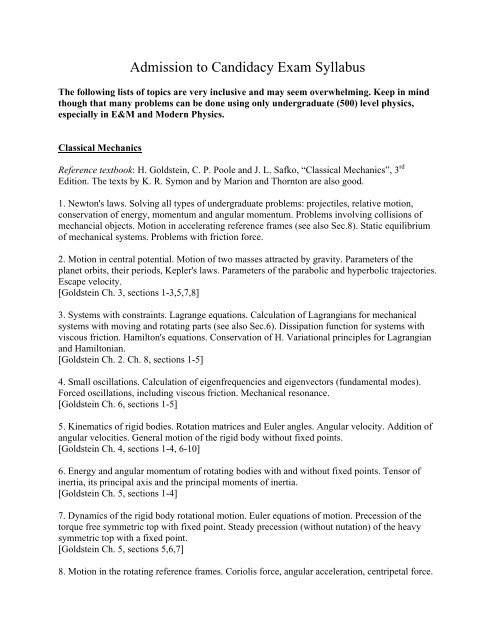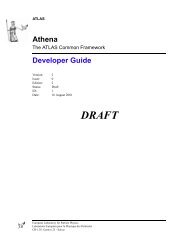Admission to Candidacy Exam Syllabus
Admission to Candidacy Exam Syllabus
Admission to Candidacy Exam Syllabus
You also want an ePaper? Increase the reach of your titles
YUMPU automatically turns print PDFs into web optimized ePapers that Google loves.
<strong>Admission</strong> <strong>to</strong> <strong>Candidacy</strong> <strong>Exam</strong> <strong>Syllabus</strong><br />
The following lists of <strong>to</strong>pics are very inclusive and may seem overwhelming. Keep in mind<br />
though that many problems can be done using only undergraduate (500) level physics,<br />
especially in E&M and Modern Physics.<br />
Classical Mechanics<br />
Reference textbook: H. Goldstein, C. P. Poole and J. L. Safko, “Classical Mechanics”, 3 rd<br />
Edition. The texts by K. R. Symon and by Marion and Thorn<strong>to</strong>n are also good.<br />
1. New<strong>to</strong>n's laws. Solving all types of undergraduate problems: projectiles, relative motion,<br />
conservation of energy, momentum and angular momentum. Problems involving collisions of<br />
mechancial objects. Motion in accelerating reference frames (see also Sec.8). Static equilibrium<br />
of mechanical systems. Problems with friction force.<br />
2. Motion in central potential. Motion of two masses attracted by gravity. Parameters of the<br />
planet orbits, their periods, Kepler's laws. Parameters of the parabolic and hyperbolic trajec<strong>to</strong>ries.<br />
Escape velocity.<br />
[Goldstein Ch. 3, sections 1-3,5,7,8]<br />
3. Systems with constraints. Lagrange equations. Calculation of Lagrangians for mechanical<br />
systems with moving and rotating parts (see also Sec.6). Dissipation function for systems with<br />
viscous friction. Hamil<strong>to</strong>n's equations. Conservation of H. Variational principles for Lagrangian<br />
and Hamil<strong>to</strong>nian.<br />
[Goldstein Ch. 2. Ch. 8, sections 1-5]<br />
4. Small oscillations. Calculation of eigenfrequencies and eigenvec<strong>to</strong>rs (fundamental modes).<br />
Forced oscillations, including viscous friction. Mechanical resonance.<br />
[Goldstein Ch. 6, sections 1-5]<br />
5. Kinematics of rigid bodies. Rotation matrices and Euler angles. Angular velocity. Addition of<br />
angular velocities. General motion of the rigid body without fixed points.<br />
[Goldstein Ch. 4, sections 1-4, 6-10]<br />
6. Energy and angular momentum of rotating bodies with and without fixed points. Tensor of<br />
inertia, its principal axis and the principal moments of inertia.<br />
[Goldstein Ch. 5, sections 1-4]<br />
7. Dynamics of the rigid body rotational motion. Euler equations of motion. Precession of the<br />
<strong>to</strong>rque free symmetric <strong>to</strong>p with fixed point. Steady precession (without nutation) of the heavy<br />
symmetric <strong>to</strong>p with a fixed point.<br />
[Goldstein Ch. 5, sections 5,6,7]<br />
8. Motion in the rotating reference frames. Coriolis force, angular acceleration, centripetal force.
[Goldstein Ch. 4, section 10]<br />
[Note: the following <strong>to</strong>pics are excluded:<br />
- In central field motion [Ch. 3] sections 9-12 are excluded<br />
- Precession of a heavy <strong>to</strong>p with arbitrary initial conditions, nutations [Ch. 5, most of section 7]<br />
- Principle of least action for the “abbreviated action” [Ch. 8, section 6]<br />
- Canonical transformation, generating functions, Poisson brackets, Hamil<strong>to</strong>n-Jacobi theory,<br />
Liouville's theorem, canonical perturbation theory [Ch. 9, Ch. 10, Ch. 12]<br />
- Chaos [Ch. 11]<br />
- Lagrangian and Hamil<strong>to</strong>nian formulations for continuous systems and fields [Ch. 13]<br />
Thermodynamics and Statistical Physics<br />
Reference textbooks:<br />
“Statistical Physics of Particles” by M. Kardar (2007).<br />
“Thermal Physics” by C. Kittel and H. Kroemer (1980, 2 nd Edition).<br />
Thermodynamics [Kardar, Ch.1, Kittel Chs. 2-10.]<br />
a) First law of thermodynamics, work, and heat transfer.<br />
b) Ideal gas law. Processes with a gas: isothermal, adiabatic, etc.<br />
c) Heat engines, Carnot cycle. Reversible and irreversible processes.<br />
d) Second law, entropy. Thermodynamic potentials (free energy, Gibbs energy).<br />
e) Third law.<br />
f) General equations of state. Maxwell relations.<br />
g) Phase transitions. Chemical potentials.<br />
Classical statistical mechanics [Kardar, Ch. 4, Kittel Chs. 1-5]<br />
a) Gibbs distribution. Microcanonical, canonical, grand canonical ensembles. Partition<br />
function.<br />
b) Derivation of thermodynamic properties for the ideal gas and for an ensemble of the twolevel<br />
systems.<br />
Quantum statistical mechanics [Kardar, Ch. 6, Kittel Ch. 1-5]<br />
a) Contribution of molecular rotations and vibrations <strong>to</strong> thermodynamics properties.<br />
b) Phonons in solid state.<br />
c) Blackbody radiation.<br />
Ideal gas in the quantum limit [Kardar Ch. 7, Kittel Ch. 7]<br />
a) Fermi and Bose gases. Partition function for indistinguishable particles. Occupation<br />
numbers.<br />
b) Non-degenerate and degenerate limits. Characteristic density of a crossover between the<br />
limits at a given temperature of the gas. Characteristic temperature of a crossover<br />
between the limits at a given density of the gas.<br />
c) Degenerate Fermi gas at T
Electromagnetism<br />
Reference textbook: J. D. Jackson, “Classical Electrodynamics”, 3 rd Edition.<br />
[The text by Griffiths is also good.]<br />
• Introduction <strong>to</strong> Electrodynamics.<br />
• Obtain the charge distribution and / or the potential for a configuration of charges or<br />
conduc<strong>to</strong>rs specified in one of many ways. [Jackson 1.1-1.6. Griffiths Ch. 2]<br />
• Solve boundary value problems in electrostatics using<br />
(i) the method of images. Specific well-known problems will be considered as well.<br />
(ii) expansions in terms of orthogonal functions as well as using Green functions.<br />
• <strong>Exam</strong>ine the effect of charge distributions at large distances using multipoles. Dielectrics.<br />
[Jackson 1.7-2.9, 3.1-3.11, 4.1-4.7. Griffiths Chs. 3,4.]<br />
• Application of the Laws of Biot and Savart and of Faraday <strong>to</strong> magne<strong>to</strong>static problems.<br />
• The basis of electrodynamics: the Maxwell equations, the potential formulation, Green<br />
functions and retarded potentials. Gauge invariance.<br />
[Jackson 5.1-5.11, 5.15-5.17, 6.1-6.5. Griffiths Chs. 5, 6, 7, 10.]<br />
• Electromagnetic radiation and its propagation in<br />
(i) Uniform homogeneous media.<br />
(ii) Understand the propagation of electromagnetic radiation in waveguides.<br />
• Obtain the transmitted wave that propagates through media by considering the effects of<br />
the electronic properties of molecules. [Jackson 7.1-7.6, 8.1-8.5. Griffiths Chs. 8,9.]<br />
• Radiation due <strong>to</strong> oscillating current distributions, including simple antennas.<br />
• The general solution <strong>to</strong> the Helmholtz equation in the radiation zone as a multipole<br />
expansion and how <strong>to</strong> obtain each term from given source distributions.<br />
• The scattering of waves by media at various wavelengths.<br />
[Jackson Ch. 9, 10.1-10.5. Griffiths Ch. 11.]]<br />
• Einstein's theory of relativity and its connections <strong>to</strong> electromagnetism. We consider<br />
especially relativistic kinematics, the electromagnetic field tensor, covariance thereof and<br />
the relativistic precession of spin. [Jackson Ch. 11. Griffiths Chs. 8, 12.]<br />
• Lagrangian for charged particles in electromagnetic fields and the motion of charged<br />
particles in electromagnetic fields using the action principle.<br />
• The energy loss of charged particles in dense media; Cherenkov radiation and transition<br />
radiation.<br />
[Jackson 12.1-12.4, 13.1-13.4, 14.1-14.3.]
Modern Physics<br />
Reference textbook: K. S. Krane, “Modern Physics”, 2 nd Edition. This is a lower-level text, so<br />
you should also consult “Suba<strong>to</strong>mic Physics” by E.M. Henley and A. Garcia.<br />
Particular attention should be paid <strong>to</strong><br />
(i)<br />
(ii)<br />
(iii)<br />
(iv)<br />
(v)<br />
(vi)<br />
Special Relativity: Time dilation, Lorentz contraction, abandonment of simultaneity,<br />
velocity addition, relativistic Doppler effect, relativistic invariants, relativistic<br />
kinematic processes including, e.g., Comp<strong>to</strong>n scattering.<br />
Basic Modern Physics: Blackbody spectra, pho<strong>to</strong>electric effect, pair production and<br />
annihilation, de Broglie waves and other <strong>to</strong>pics in basic quantum mechanics.<br />
Nuclear physics - basic types of radioactive decay, fission, fusion.<br />
Basic astrophysics - energy production in stars. Hydrostatic equilibrium in main<br />
sequence stars, white dwarfs and neutron stars, remnant black-body radiation, general<br />
knowledge of the Big Bang Scenario.<br />
Particle physics - broad outlines of the Standard Model, quarks, lep<strong>to</strong>ns, bosons.<br />
Hadrons and their organization, symmetry principles and conservation laws.<br />
Condensed matter physics - band structure, metals/insula<strong>to</strong>rs, free electron model,<br />
doped semiconduc<strong>to</strong>rs.<br />
Students are expected <strong>to</strong> be very familiar with the contents of the following courses: PHYS 501<br />
(Modern Physics), 502 (Quantum Physics), 506 (Thermal Physics), 511 (Nuclear/Particle<br />
Physics) and 512 (Condensed Matter Physics).<br />
PHYS 506 covers both Thermodynamics and introduction <strong>to</strong> Statistical Physics (quantum<br />
distribution functions and their consequences etc.).<br />
PHYS 511 is an introduc<strong>to</strong>ry course in nuclear and particle physics and covers symmetry<br />
principles, conservation laws of strong and weak interactions, nuclear liquid drop model, nuclear<br />
shell model, fission and fusion, quark models etc. Students are expected <strong>to</strong> also know about<br />
neutrino oscillations and K 0 -K 0 bar (and similar) oscillations as well as the basis for this mixing.<br />
PHYS 512 is an introduction <strong>to</strong> condensed matter physics. It covers the Drude, Sommerfeld, and<br />
Fermi free electron gas models for metals, Bloch’s theorem, the concept of energy bands, and the<br />
effective mass, electrical conduction in semiconduc<strong>to</strong>rs and insula<strong>to</strong>rs, semiconduc<strong>to</strong>r devices:<br />
including p-n junctions, the transis<strong>to</strong>r, and the semiconduc<strong>to</strong>r laser, and magnetism: para-, dia,<br />
and ferro/ferri.
Quantum Mechanics<br />
Reference textbook: J. J. Sakurai, “Modern Quantum Mechanics”, Revised Edition.<br />
[The text by Griffiths is also good.]<br />
The two-slit and Stern Gerlach experiments and their implications. Formal structure of quantum<br />
mechanics using Dirac notation and state vec<strong>to</strong>rs. Expansion coefficients, matrix representations<br />
and opera<strong>to</strong>rs, with special emphasis on hermitian and unitary opera<strong>to</strong>rs.<br />
Time development of quantum systems. Time development is illustrated using the Schrodinger<br />
and Heisenberg pictures, using the time evolution opera<strong>to</strong>r, using the Schrodinger equation and<br />
using the Feynman propaga<strong>to</strong>r and path integral approaches. The Aharonov-Bohm effect and<br />
gauge invariance.<br />
Concepts and techniques of angular momentum. Rotation opera<strong>to</strong>rs and density matrices.<br />
Addition of angular momenta, including physical applications and opera<strong>to</strong>r techniques. Tensor<br />
opera<strong>to</strong>rs and the Wigner Eckart theorem.<br />
Symmetry operations in quantum mechanics. Continuous symmetries such as rotational<br />
symmetry as well as discrete symmetries such as parity and time reversal. Identical particles and<br />
the constraints that they impose. Two-electron systems such as the helium a<strong>to</strong>m.<br />
Time-independent and time-dependent perturbation theory including in particular a<strong>to</strong>mic<br />
physics. The interaction of a<strong>to</strong>ms with electromagnetic radiation.<br />
Scattering theory. The Born approximation and the optical theorem. Spherical waves. The<br />
method of partial waves. Modifications dealing with identical particles and symmetry<br />
considerations. Resonance scattering and inelastic scattering.<br />
[This list is essentially all of Sakurai’s text minus sections 3.8, 7.12, 7.13.]
















